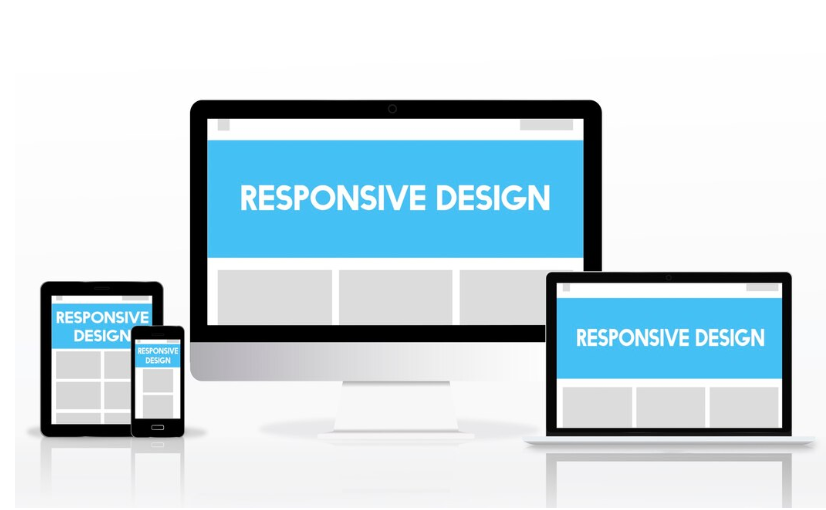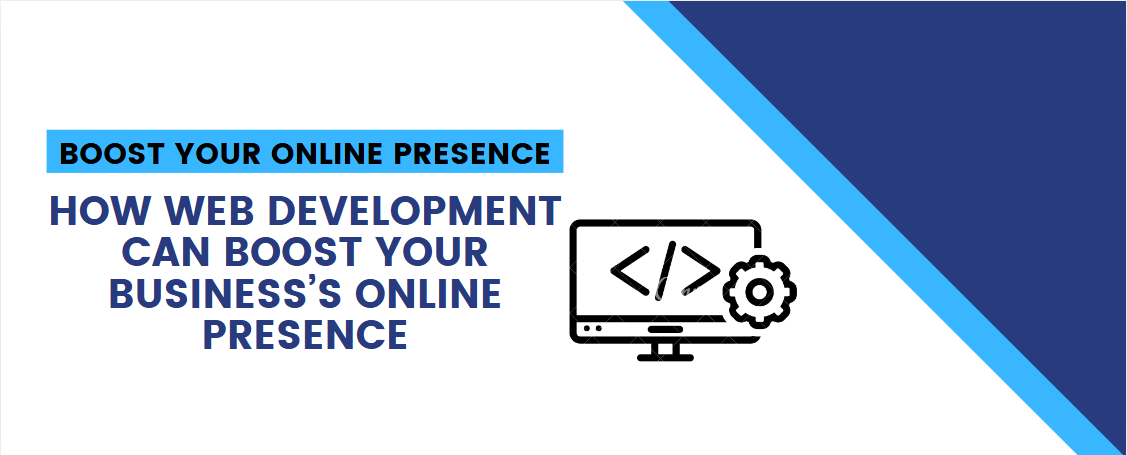In today’s digital world, having a strong online presence is no longer optional – it’s essential for the growth and success of your business. Whether you’re a small local shop or a growing e-commerce empire, your website is often the first impression potential customers will have of you. And that first impression matters.
In this blog, we’ll dive into how web development can help boost your business’s online presence and why investing in professional web development is crucial for staying competitive in today’s fast-paced digital landscape.
The Importance of Online Presence for Your Business

Before we get into the nitty-gritty of web development, let’s take a moment to understand why a strong online presence is so critical. Studies show that 97% of consumers search for local businesses online before making a purchase. And if your website doesn’t show up in those searches, you’re missing out on a huge chunk of potential customers.
A well-developed website can do much more than just showcase your products or services – it serves as your business’s digital storefront, and just like a physical store, it needs to be inviting, easy to navigate, and reliable.
The Power of First Impressions
Imagine walking into a store and finding cluttered shelves, poor lighting, and confusing signage. Chances are, you’d leave quickly and might not come back. The same thing happens when people land on a poorly designed website. In fact, 38% of people will stop engaging with a website if the content/layout is unattractive. So, having a clean, functional, and professional website can be the difference between a visitor staying on your site or bouncing off to a competitor.
But how can web development help your business stand out? Let’s take a closer look.
1. A Fast and Responsive Website Keeps Customers Engaged
One of the key factors that impact your website’s success is its speed and responsiveness. According to Google, 53% of mobile users abandon a website if it takes more than 3 seconds to load. That’s a massive loss in potential customers just because your site is slow.

With proper web development, you can optimize your site for faster load times, which will keep visitors happy and engaged. A website that loads quickly also improves your search engine ranking. Google uses website speed as one of its ranking factors, so a slow site could hurt your SEO efforts.
Moreover, a responsive design ensures that your website looks and works great on any device – be it a desktop, tablet, or smartphone. With more than half of all web traffic now coming from mobile devices, having a mobile-friendly site is no longer optional.
Key Stats:
- 53% of mobile users abandon a site if it takes more than 3 seconds to load.
- 57% of users won’t recommend a business with a poorly designed website on mobile.
2. User Experience (UX) and Website Navigation
User experience (UX) is the foundation of any good website. If your website is difficult to navigate or hard to use, visitors will quickly become frustrated and leave. Studies show that 88% of online consumers are less likely to return to a site after a bad experience.

Web development can ensure that your website is easy to navigate, with a clean layout and well-organized content. An intuitive design helps users find what they’re looking for quickly, which improves both the user experience and conversion rates.
For example, if you’re running an e-commerce store, a smooth checkout process and easy-to-find product categories are key to turning visitors into buyers. With proper web development, you can streamline the user journey, reduce friction, and increase the likelihood of a purchase.
Key Stats:
- 88% of consumers are less likely to return to a website after a bad experience.
- 94% of people cite bad design as the reason they mistrust or reject a website.
3. Boost Your Credibility with Professional Design
In today’s competitive marketplace, credibility is crucial. A professionally designed website instantly boosts your business’s credibility and trustworthiness. Consumers are more likely to trust businesses with polished, well-designed websites than those with outdated or poorly constructed sites.

In fact, 75% of users make judgments about a company’s credibility based on its website design. A professional design gives the impression that your business is legitimate, reliable, and serious about providing value to customers.
On the other hand, a poor design – with broken links, low-quality images, or outdated content – sends the wrong message. If your website doesn’t look trustworthy, potential customers are less likely to engage with your business, no matter how great your products or services may be.
Key Stats:
- 75% of users judge a business’s credibility based on website design.
- 46% of users say that website design is the top factor in deciding the credibility of a business.
4. Search Engine Optimization (SEO)
Having a great website is one thing, but having people find it is another. Search engine optimization (SEO) plays a huge role in improving your website’s visibility on search engines like Google. When people search for products or services related to your business, SEO helps ensure that your website shows up on the first page of results.

Web development isn’t just about making your website look pretty – it’s also about making sure it’s built in a way that search engines can easily crawl and index. This includes things like optimizing page load speed, using proper heading tags, adding alt text for images, and creating SEO-friendly URLs.
A well-developed website with built-in SEO best practices can significantly improve your ranking on search engines, drive organic traffic to your site, and help you connect with your target audience.
Key Stats:
- 93% of online experiences begin with a search engine.
- 75% of users never scroll past the first page of search results.
- SEO leads have a 14.6% close rate, compared to just 1.7% for outbound leads like cold calls.
5. Social Media Integration and Sharing
Social media is a powerful tool for driving traffic to your website, but only if your website is set up to integrate seamlessly with your social channels. A well-developed website can include easy-to-use social media sharing buttons, which encourage users to share your content, products, or services with their network.
 By integrating your website with social media platforms like Facebook, Instagram, Twitter, and LinkedIn, you’re not just boosting your online presence – you’re also expanding your reach. When people share your content, they’re essentially promoting your business for free.
By integrating your website with social media platforms like Facebook, Instagram, Twitter, and LinkedIn, you’re not just boosting your online presence – you’re also expanding your reach. When people share your content, they’re essentially promoting your business for free.
Web development can also include social media feeds directly on your site, keeping your content fresh and engaging. This can help build brand awareness, increase traffic, and create a sense of community around your business.
Key Stats:
- 73% of marketers say that their efforts through social media marketing have been “somewhat effective” or “very effective” for their business.
- 94% of people are likely to share content they find valuable or interesting.
6. Conversion Rate Optimization (CRO)
Having traffic to your website is great, but it’s not enough. You need to convert that traffic into customers. This is where Conversion Rate Optimization (CRO) comes in. Web development plays a huge role in optimizing your site to convert visitors into leads or sales.
 CRO involves improving elements like call-to-action buttons, product descriptions, and landing page layouts to increase the likelihood that visitors will take action. Even small changes, like simplifying a form or making your checkout process easier, can have a significant impact on conversion rates.
CRO involves improving elements like call-to-action buttons, product descriptions, and landing page layouts to increase the likelihood that visitors will take action. Even small changes, like simplifying a form or making your checkout process easier, can have a significant impact on conversion rates.
A well-developed website with optimized design and functionality can lead to higher conversion rates, which ultimately means more revenue for your business.
Key Stats:
- Conversion rate optimization can increase your website’s conversion rate by 5-10%.
- A 1-second delay in page load time can reduce conversions by 7%.
7. Analytics and Tracking Performance
Lastly, web development allows you to track and analyze your website’s performance. Tools like Google Analytics can provide insights into how visitors interact with your site, what pages they visit, and where they drop off.

By using this data, you can make informed decisions about what changes or improvements need to be made to your site. Whether it’s improving content, redesigning a page, or optimizing your site for better performance, having the right data at your fingertips is crucial for continuous improvement.
Key Stats:
- Data-driven companies are 23 times more likely to acquire customers.
- 55% of businesses use analytics to improve user experience and conversion rates.
Conclusion
In today’s digital age, your website is more than just a virtual business card – it’s a critical tool for building trust, attracting new customers, and driving revenue. Web development is key to creating a website that’s fast, functional, and optimized for both users and search engines. With the right web development strategies, you can ensure that your business stands out online and reaches its full potential.
Whether you’re starting from scratch or looking to revamp an existing site, investing in professional web development is one of the best ways to boost your business’s online presence and stay ahead of the competition. So, don’t wait – start working on your website today and watch your business grow!


